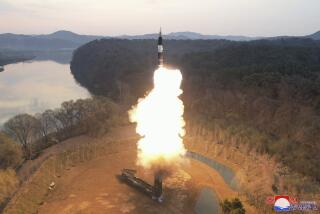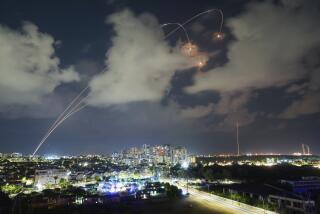Tougher Test Delayed for Missile Net
- Share via
WASHINGTON — The head of the Pentagon’s controversial program to build a missile shield said Wednesday that the Pentagon won’t ratchet up its testing as rapidly as hoped because the antimissile system has not proved reliable.
Air Force Lt. Gen. Ronald T. Kadish said the next test will essentially be a repeat of the July 14 exercise in which the system intercepted a mock warhead, rather than a more complex and difficult follow-up test.
Although Kadish said it is simply prudent to replay the July test to make sure the technology works, the decision to avoid making the next test more complex gives ammunition to critics of the missile plan who say it can’t work.
The system, a ground-based interceptor, is designed to destroy an intercontinental ballistic missile in space before its warheads speed toward Earth. But though it successfully found and smashed a dummy warhead last month, it has not been tested against more than one decoy trying to throw it off course.
Director Seeks Better ‘Comfort Level’
Kadish, director of the Ballistic Missile Defense Organization, said after the July test, which involved a single balloon decoy, that the next test might include a number of decoys. But Kadish told reporters Wednesday that the test scheduled for October will instead be an exact replay of the July test.
“It is still not totally comfortable for me to say that we can make the hit-to-kill technology work consistently, even in that simple scenario” with a single decoy, Kadish said. “. . . I am worried that we have the reliability we need in this system’s basic functionality . . . . We need a little bit more comfort level.”
Kadish’s comments were his most definitive yet on where the interceptor testing stands and on what is envisioned for the technology--the most advanced of those the U.S. is researching to protect against incoming warheads.
The remarks indicate how cautiously the Pentagon is proceeding with the tests, which cost $100 million each and have taken on enormous political importance as the Bush administration seeks a 57% hike in spending for its missile defense plan.
Military analysts said the decision to conduct the test again under the same conditions was not surprising, given the years and extensive trials it customarily takes to develop weapon technologies. Nor, they said, is it necessarily indicative of major problems with the antimissile technology the Pentagon has developed to date.
“This is still early on in the testing regimen. I think we can’t fault him in trying to fully test one thing before moving on to the next,” said William Kincade, professor of military strategy and technology at American University’s School of International Service. “One criticism of the [missile program] has been whether they are pressing much too rapidly with these tests. It would seem to me to be a sign of caution to repeat the July test in October to give yourself another firm data point.”
But the problems the Pentagon faces in developing an interceptor that can distinguish between decoys and a true incoming missile are immense, analysts said.
“It does cut to the heart of the real limitation of this particular technology, which is it’s going to have a hard time with decoys,” said Michael O’Hanlon, a defense analyst at the nonpartisan Brookings Institution in Washington. “It’s still the biggest challenge because they have no sensors that could physically distinguish a warhead wrapped in a balloon from a decoy wrapped in a balloon. They just don’t. Therefore they are always going to have to approach this decoy system skittishly.”
Plans for $2 Billion Worth of Tests
The July success was the second time in four tests since October 1999 that an interceptor has hit its target. The Pentagon plans 20 tests of the system at a total cost of about $2 billion. The testing, combined with plans to build a missile test site in Alaska, could force the abandonment of the 29-year-old treaty with Russia that limits antimissile systems.
Kadish said he was pleased with the results of the July test, in which an interceptor launched atop a missile from Kwajalein Atoll in the Marshall Islands found its target 144 miles into outer space and smashed it to pieces. The target missile, carrying a mock warhead and a 5.5-foot Mylar balloon decoy, had been launched from Vandenberg Air Force Base in Santa Barbara County.
As in previous tests, the target signaled its location to the interceptor with a beacon that the Pentagon described as necessary only to make up for the lack of an advanced “X-band” radar that the military plans to build. That has been fodder for criticism by missile defense critics who say the use of the beacon rigs the tests.
“We don’t like [relying on such a beacon], but that’s the way it is,” Kadish said.
The interceptor technology is the most advanced of several the U.S. is researching to protect against incoming warheads, including lasers aboard modified Boeing 747 aircraft and sea-launched interceptors that Kadish said may be five to 10 years from being ready to shoot down missiles.
Kadish said he is confident that the interceptor will eventually be able to distinguish an incoming missile from decoys that a foe would probably use to try to slip a missile through U.S. defenses.
He said he does not expect to phase more realistic countermeasures, such as multiple decoys, into the tests until at least next year.
“We’re still feeling our way with this,” Kadish said.
More to Read
Sign up for Essential California
The most important California stories and recommendations in your inbox every morning.
You may occasionally receive promotional content from the Los Angeles Times.













